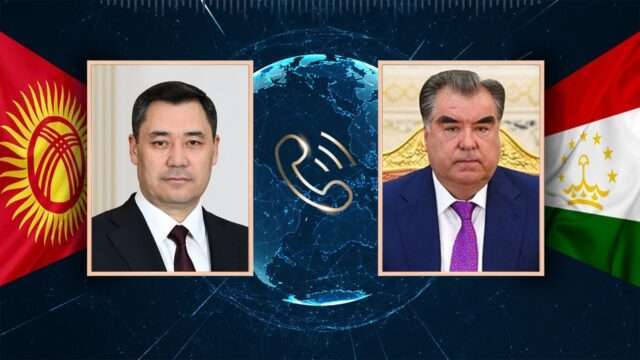
In a phone call, Tajik President Emomali Rahmon discussed bilateral relations with Kyrgyz President Sadyr Zhaparov and the delimitation of the common border necessary to resolve Tajikistan-Kyrgyzstan territorial disputes which in the past have erupted in border clashes.
- Border demarcation might be the only resolution for the territorial disputes which has opposed Tajikistan and Kyrgyzstan since the outbreak of the Soviet Union.
- Whether Tajikistan and Kyrgyzstan would reach a border demarcation, Central Asia will increase stability and security by avoiding potential clashes and a military escalation which might result in a conflict.
- Even though the phone call between the two presidents seems to be a conciliatory gesture, the parties need to resolve the tricky issues related to the natural resources of the border area.
Background
On the 30th anniversary of diplomatic cooperation between Tajikistan and Kyrgyzstan, Tajik President Emomali Rahmon phoned Kyrgyz leader Sadyr Zhaparov. The leaders of the republics noted that from the beginning of 1993 to January 2023, the countries achieved positive results in the field of politics, trade, economy, culture and the humanitarian sphere.
The heads of state agreed that all issues should be resolved exclusively by peaceful means, in the spirit of friendship and good neighbourliness. Rahmon and Zhaparov paid attention to the demarcation of the common border and noted that, at the moment, the length of the agreed border line is approximately 625 kilometres. It remains to decide on another 359 kilometres of a common border. Before the telephone conversation, the presidents exchanged congratulatory messages. In his letter, Rahmon expressed confidence that Tajik-Kyrgyz relations contribute to maintaining peace and stability in Central Asia.
On September 14-17, 2022, armed clashes occurred on the Batken region’s border in southern Kyrgyzstan between the Tajik and Kyrgyz military forces. In the last ten years, more than 150 tensions and conflicts were recorded between the two countries concerning resource access and use clashes between Kyrgyz and Tajik border communities.
Why does it matter?
Border disputes are a threat to regional stability in Central Asia. What happened in September 2022 at the Tajik-Kyrgyz border highlighted how the two Central Asian republics must overcome territorial issues to avoid armed clashes and a military escalation that might end in a conflict.
Rahmon and Zhaparov’s phone call is a significant diplomatic step in delimitating the common border and avoiding future clashes. By contrast, natural resources and the location of houses in a chessboard form of border communities represent the most complex challenge both governments should face if they want to resolve territorial issues.
Indeed, the use of water resources represents another incentive for the conflict. Kyrgyzstan and Tajikistan share about 40 channels. Some of these channels rise in Kyrgyzstan and flow to Tajikistan and vice versa. Many Kyrgyz farmers complain that Tajiks living upstream of the river use too much water and fewer remains for Kyrgyz farmers living downstream. In turn, downstream Tajik communities complain about too little water arriving in their territories. This conflict arises every year during the irrigation period from April to June.
The demarcation of the common border might bring stability and security to Central Asia and increase Tajik and Kyrgyz attractiveness for foreign companies and investors interested in setting up a business in the region. Indeed, Central Asia plays a decisive role in Beijing’s Belt and Road Initiative and Moscow’s Eurasian Economic Union. Therefore, Tajikistan and Kyrgyzstan might benefit from increasing internal security and easing transfrontier trade between the countries.
Russia might benefit from the stabilisation of the Tajik-Kyrgyz border. Indeed, both countries are members of the Collective Security Treaty Organisation (CSTO), and their recent military escalation in September 2022 marked a low point in Moscow’s military organisation.
